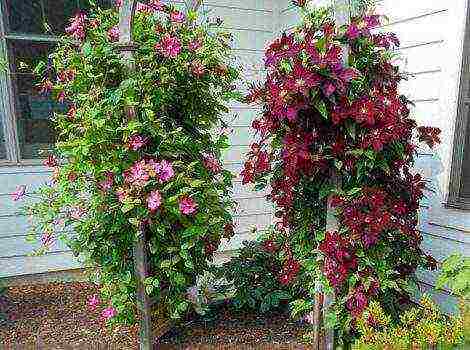Content
- 1 Weigela features
- 2 Landing weigela
- 3 Weigela care
- 4 Weigela after flowering
- 5 Main types and varieties with photos and names
- 6 Description
- 7 Weigela: photo, planting and care in the open field
- 8 Soil, planting dates and preparation
- 9 Watering and caring for weigela
- 10 Wintering weigela
- 11 Spring pruning
- 12 Reproduction
- 13 Shrub species
- 14 Weigela blooming
- 15 Weigela hybrid
- 16 Weigel Middendorf
- 17 Weigela early
- 18 Diseases and pests
- 19 Use in landscape design
Weigela is directly related to the honeysuckle family. This plant is represented by shrubs. The plant was named after the German Christian Ehrenfried von Weigel, who was a botanist, chemist and pharmacologist. Under natural conditions, this plant is found in the eastern and southeastern parts of Asia, in the Far East and on the island of Java. The genus unites 15 species represented by deciduous shrubs. Only 7 species and 10 varieties are cultivated, which are highly decorative. Weigela not only has a very effective appearance, but is relatively unpretentious, and it can be easily propagated.
Weigela features

The plant loves moisture and grows quite well in the shade. This upright shrub does not form stolons. Opposite petiolate leaf plates do not have stipules, they are serrate-serrate or serrate. Bell-shaped or funnel-shaped flowers are about 5 centimeters long. Flowers are solitary or are part of loose inflorescences. They can be painted in cream, carmine red, pink, yellow and other colors, while often during flowering, the color changes from a paler shade to a brighter one. The fruits are represented by a bivalve box with small seeds inside.
Landing weigela
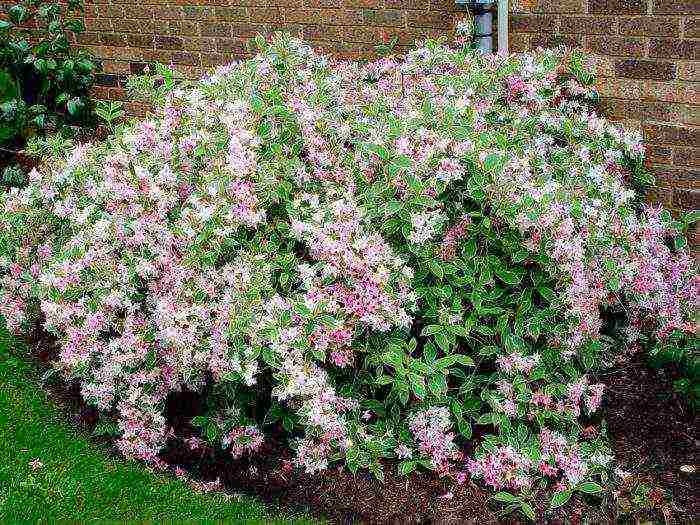
What time to plant
The best time to disembark a weigela is spring. In this case, it is necessary to have time to plant the plant before the buds swell, but the earth should already warm up, in which case it will take very well. The shrub planted in the fall dies during the first wintering.
It is best to choose a place for planting on a hill, while it must be protected from drafts and north winds, which can cause shedding of flowers and buds. Better to plant the weigela on the south side of the building. In good light, the flowers are very bright and the flowering is plentiful. For planting, you need loose soil with a lot of humus. Loamy or clayey soil, neutral or slightly alkaline, is suitable. It should be borne in mind that Weigela middendorffiana can be planted in peaty, slightly acidic soil. The planted seedling must be at least 3 years old.
How to plant
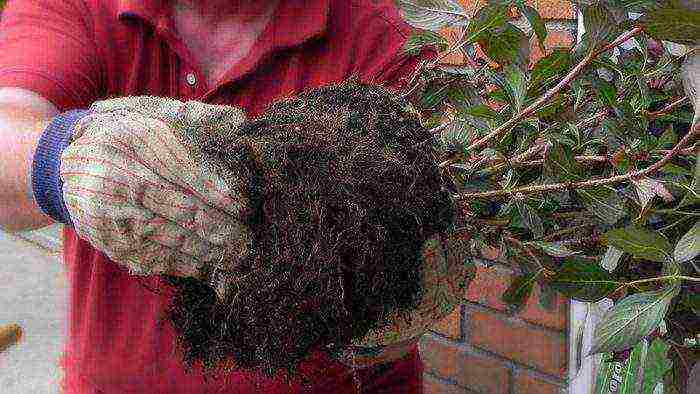
The depth of the landing pit is from 30 to 40 centimeters. If the soil is infertile, then the pit should be made deeper, because on the drainage layer (height 15 centimeters), which can be made from gravel, fragments of brick or sand, a layer of nutrient-rich soil should be laid (1.5 buckets of compost plus 100 grams of nitrophosphate ). Fertilizer should be thoroughly mixed with compost. In order for the seedling to begin better, its roots can be treated with a substance that stimulates root growth (Viva + or Radifarm).
If the weigela seedling is of a medium-sized variety (no higher than 100 centimeters), then a distance of at least 80 centimeters should be left between the bushes, the gaps between the bushes of high varieties (up to 250 centimeters high) should be from 150 to 200 centimeters. During planting, do not forget to straighten the roots of the seedling, the soil will need to be gradually poured into the hole and tamped in order to exclude the possibility of voids formation. It is possible to deepen the root collar by only 10–20 mm, but it is desirable that when the soil settles after watering, it is at the same level with the ground.The planted plant must be well watered, and the surface of the soil must be sprinkled with a layer of mulch.
Weigela care
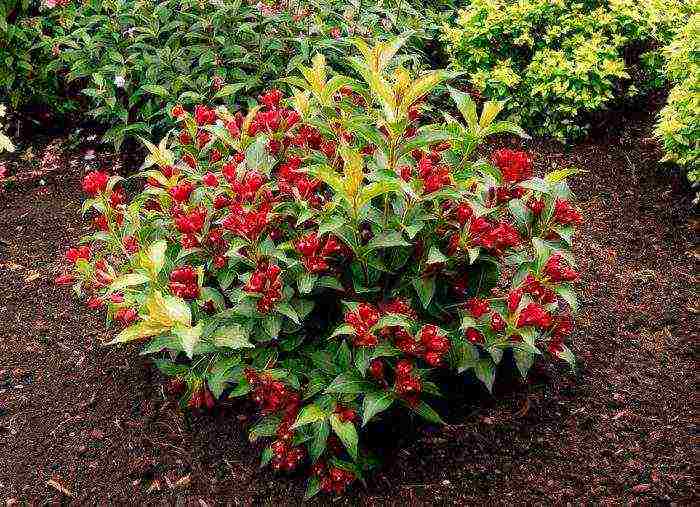
Spring
Growing such a shrub is easy, and even a beginner can handle it. It is necessary to water the weigela only during the dry period, while a large amount of water is used (if the near-trunk circle is mulched, then watering will be more rare). You also need to do timely weeding and loosening of the soil, which is performed very carefully with only half the bayonet of a shovel, otherwise the root system can be damaged. You also need to feed the plant in a timely manner, while if you added nitrophosphate and compost during planting into the hole, then the bush will not need feeding for 2 years. In the third year, at the beginning of spring, the weigela needs to be fed, for this, a complete mineral fertilizer is applied to the soil, for example: diammofoska, ammofoska, Kemiru-lux or other fertilizers, which include potassium, phosphorus and nitrogen. In the last days of spring or the first - summer, during budding, it is necessary to make a second top dressing, while you need to take phosphorus and potassium fertilizers (potassium sulfate, superphosphate, etc.). Thanks to this, the plant will bloom for a long time and abundantly, and the branches will also strengthen, which is good for wintering. The third time the bush is fed during digging in the fall, while taking wood ash (for 1 m2 you will need 200 g of top dressing). You can use Kemira-autumn fertilizer for this purpose, while the dosage should be seen in the instructions.
Bloom
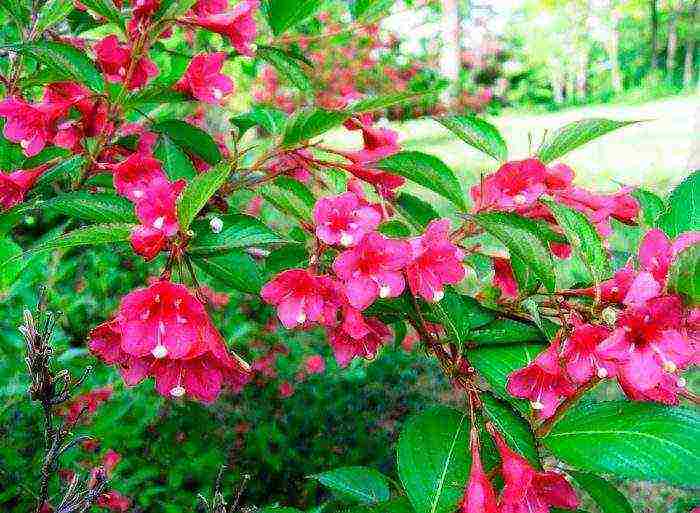
This shrub blooms 2 times per season. The first lush flowering is observed from the second half of May to mid-June, while flowers appear on the shoots of the last year. The second time the shrub blooms in August and blooms until September. At the same time, flowering is less abundant than in spring, and flowers grow on the shoots of the current year. During flowering, the plant looks very impressive.
Reproduction of weigela

The plant can be propagated simply by seed. It should be borne in mind that their germination is maintained only for 1-2 years, therefore, experienced gardeners do not recommend sowing seeds in boxes or greenhouses. The easiest way to propagate weigela is self-seeding. In spring, when shoots appear from the seeds that have fallen into the ground, it will be necessary to select the strongest ones, and remove the rest. They will need rearing, which lasts 2 years, only after that they can be transplanted to a permanent place. But it must be borne in mind that with this method of reproduction, varietal characteristics are not always preserved. In this regard, gardeners with considerable experience recommend propagating vegetatively, namely by layering, young shoots from the stump, as well as summer green or last year's semi-lignified cuttings. For cutting cuttings, the length of which should be from 10 to 15 centimeters, you should choose this year's green shoots (cut in the last days of June) or last year's semi-lignified shoots (cutting is carried out before sap flow begins), or you can cut the root shoots. The leaf plates located at the bottom of the cuttings must be torn off, while the upper ones must be shortened by ½ part. The slice from the bottom must be dipped into Kornevin. The cuttings are planted in soil consisting of peat and sand, while its surface should be covered with a layer of sand equal to 4 centimeters. The shank must be deepened by only 10 mm, no more. Each plant should be covered with a cut plastic bottle or glass jar. The shelter needs to be cleaned every day for a while for airing and watering. The young shoots that have appeared must be pinched in order for the plant to be more bushy.
Layers should be propagated in a different way. Choose the sturdiest bottom shoot and bend it to the ground. At the point of contact with the ground on the shoot, you need to cut the bark slightly. Then it is fixed on the surface of the soil and sprinkled with soil.Already next spring, the cuttings will take root completely. Cuttings and cuttings can be transplanted to a permanent place only at the age of three.
How to trim properly

Weigele, like all shrubs, needs pruning. Young bushes need pruning only for sanitary purposes. To do this, at the beginning of spring, you need to cut off those branches that thicken the plant, as well as sick, injured and damaged by frost. Older plants need formative pruning, which should be done after the weigela has bloomed for the first time (in the middle of summer), while young shoots should not yet grow. It is worth remembering that during the re-flowering, flowers appear on the shoots of the current year. In this regard, if you did not carry out the formative pruning in time, and new branches began to grow, then it is recommended to postpone it until next year. Adult shrubs need anti-aging pruning, carried out once every 3 years, while all branches that are more than 3 years old need to be cut off, and those that remain should be cut off by 1/3. In some cases, it may be necessary to prune all branches; after this pruning, the weigela recovers very well.
Diseases and pests

Often leaf-eating caterpillars and aphids settle on this shrub. During a long period of heat and drought, thrips or spider mites can settle on the plant. However, by the beginning of the drought period, the first flowering of the weigela is already ending. In order to destroy these harmful insects, it is recommended to use pesticides such as nitrafen, rogor or celtan, but it should be borne in mind that they are harmful to the environment. There are more harmless means for fighting harmful insects - these are insecticidal infusions made from plants such as: hot pepper, wormwood or garlic. If the planted seedlings turn yellow and begin to fade, then this is most likely due to the fact that a bear has started up in the root system or the larvae of the May beetle have settled. They could get into the ground along with compost or humus during planting. To destroy them, it is necessary to water the bush with a solution of actara or karbofos.
Weigela most often suffers from gray rot, rust, and spotting. In order to get rid of a fungal or bacterial disease, you need to treat the bush with Bordeaux liquid (copper sulfate mixed with milk of lime). For preventive purposes, you can treat the plant during the appearance of leaves with Topsin's solution (3%).
Weigela after flowering
Seed collection

The seeds ripen in September and are harvested in October after the capsules begin to crack. In order for the seeds not to spill out onto the surface of the soil, it is necessary to wrap several pieces of testes with gauze in September and fix it on the branch. After the box is ripe, you need to carefully cut it and bring it into the room. There you can remove the gauze and sprinkle the seeds onto a newspaper. After the seeds are dry, they need to be poured into a paper bag, on which do not forget to mark the name of the plant, its variety and the date when the seeds were collected. They must be placed in a dark, dry place where they will be stored until spring. It should be remembered that seeds retain good germination only for 1–2 years, while shrubs grown from seeds may not retain the varietal characteristics of the parent plant.
Wintering
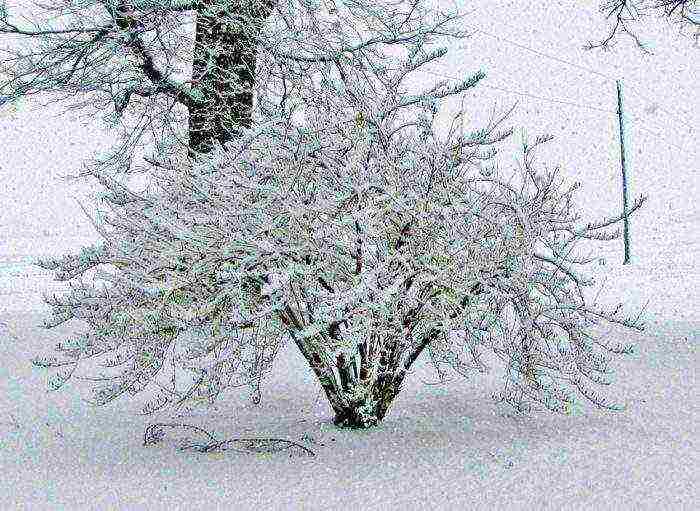
After the end of leaf fall (in the last days of October or the first - November), you need to cover the near-trunk circle of the shrub with a layer of soil, while the height of the mound should be from 15 to 20 centimeters. It is recommended to bend the branches to the soil surface and fix them. From above, the bush is covered with spunbond or roofing material, while the shelter is pressed so that it is not blown away by the wind. You can not bend the branches, but tie them with twine or rope, pulling them well.Fence the plant with a plastic or metal net. It is necessary to pour dry fallen leaves inside the resulting structure. On top, the structure must be insulated with a covering dense material.
Main types and varieties with photos and names
For gardeners of middle latitudes, weigela varieties are most suitable, which are resistant to frost. These include the species and varieties described below.
Early weigela, or weigela pleasant (Weigela praecox)
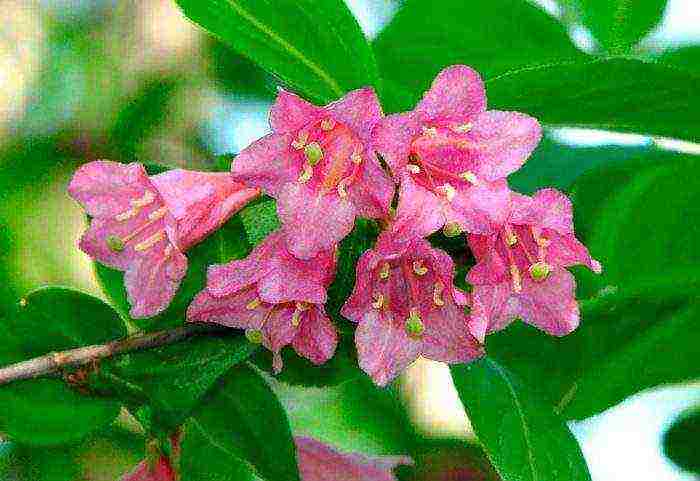
In natural conditions, it grows in the Far East. The bush reaches a height of about 200 centimeters. There is pubescence on the foliage surface. The crown is spherical. The outer part of the flowers is deep pink. Inflorescences consist of 2 or 3 flowers, while they grow on the lateral shoots of this year. It happens that the throat of the flower has a white-yellow color, in the buds the flowers are painted purple. Flowering begins in the last days of May and lasts from 10 to 30 days. The variegated variety of weigela variegated is of the greatest interest. On the surface of the green leaf plates there are specks of yellow color, in the summer they acquire a cream color.
Weigela flowering, or weigela florida (Weigela florida)
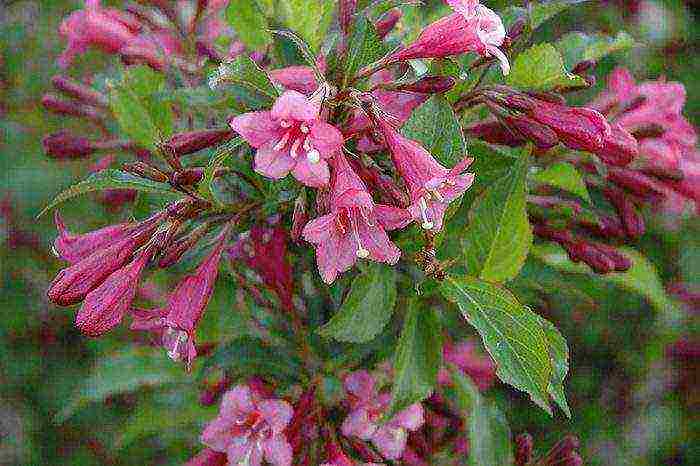
The bush reaches a height of 300 centimeters. There are 2 rows of hairs on the surface of the shoots. Short-petiolate serrated leaf plates on the front side have pubescence located along the central vein, while on the seamy surface all veins have pubescence. The inflorescences consist of 3 or 4 flowers, painted in a deep pink color, which open in the last days of May. Flowering lasts approximately 20 days.
Popular forms:

- Weigela purple, or weigela red (Weigela Purpurea). The height of the bush is about 150 centimeters, there is a lush crown. The leaf plates are brownish-red in color, the bright pink flowers have a yellow throat. Bloom is observed in June and July. Nana Purpurea is very similar to weigela purple, but the shrub is smaller.
- Alba. It is a dwarf form. White flowers turn pink during wilting.
- Variegata... This form is very beautiful and the most frost-resistant. Has small leaves. The racemose inflorescences are composed of deep pink flowers.
- Weigela pink (Weigela florida Bunge)... The outer surface of the flowers is carmine pink, while the inner surface is almost white.
- Weigela florida Victoria... The height of the bush is about 100 centimeters. The foliage is brownish red, and the flowers are purple in color.
Weigela hybrid (Weigela hybrida)
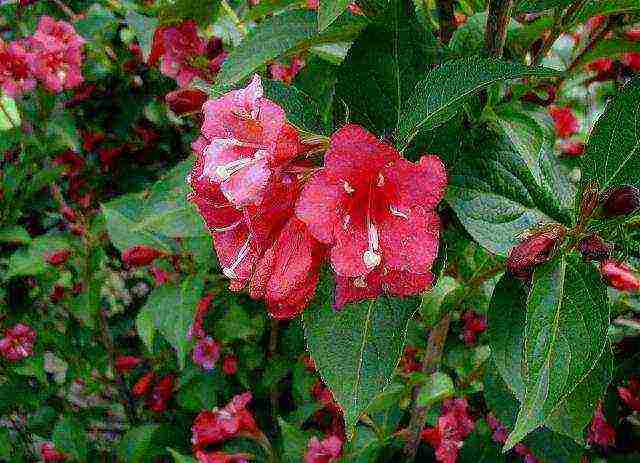
Has a spreading crown, lush flowering. The height of the bush is about 150 centimeters. Fragrant flowers have a funnel-shaped tubular shape, they can be part of loose inflorescences or be single. Depending on the variety, the color of the flowers can be pink, lilac, purple, white, violet-red.
Popular varieties:
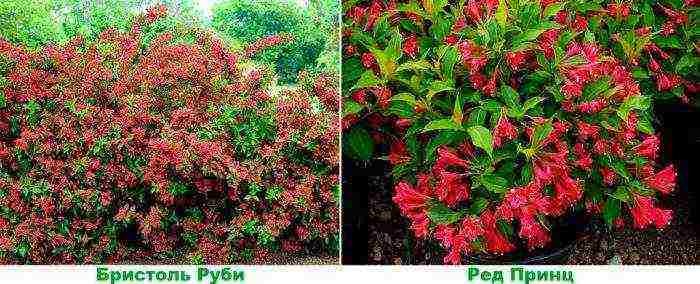
- Bristol Ruby... The variety appeared in 1941 in the United States. The bush can reach a height of 250-300 centimeters, while the diameter of its crown is 350 centimeters. The leaves are deep green in color. The pink flowers have ruby-red edges, sometimes their center is colored orange. This fast growing plant begins to bloom in the last days of June.
- Red Prince... The variety was bred in the USA. A compact bush in height can reach 150 centimeters. Has a spreading crown, drooping branches. Bright red flowers look very beautiful against the background of green leaves.
Weigela middendorff (Weigela middendorffiana)

The height of the bush can vary from 100 to 150 centimeters. Ascending shoots. Large (from 3 to 4 centimeters) yellow flowers have orange spots in the throat. They are part of low-flowered inflorescences of 2-6 pieces or are single. Flowering is observed twice per season.
Also, quite often gardeners grow abundantly flowering weigela, pleasant weigela, early weigela, Japanese weigela, garden weigela, Maximovich weigela and Korean weigela.
If you ask what flowering plant you are happy to see in your garden in spring, then most of the respondents will not hesitate to remember about lilacs, jasmine and rhododendron. Indeed, the wildly blooming lilac is the recognized queen of our gardens, squares and front gardens. But time dictates new trends in garden design. More and more actively on the lawns of summer cottages there are hybrids, heat-loving southern plants, thanks to the efforts of breeders and amateur gardeners, zoned and adapted for growing in our latitudes. One of these plants is weigela (or flowering weigela). The very name of this shrub speaks of its main advantage - an exuberant, bright, truly royal flowering.
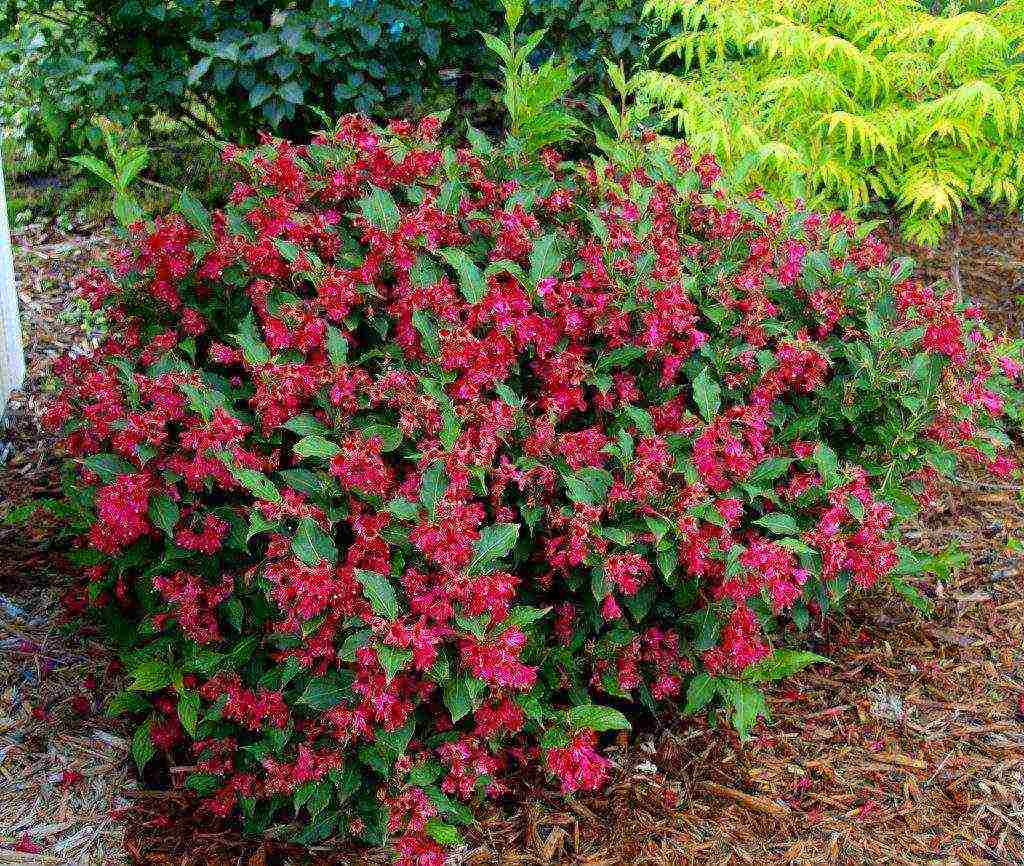
Weigela Red Prince
Weigela belongs to the honeysuckle family; about 15 species are known in the genus of these shrubs, common in Southeast Asia and the Far East. All weigels are deciduous shrubs, which are divided into dwarf varieties, up to 50 centimeters high, as well as wild and hybrid species up to 2-3 meters high. Weigela stands out among other flowering shrubs for its particularly lush, bright and decorative flowering. The bush begins to bloom in May and continues to delight the eye for about almost the entire June.
In spring, weigela stems are covered with paired elongated leaves, lush single or umbrella inflorescences are formed at the ends of the stems. Weigela flowers are large, elongated, similar to elongated bells for 4-5 centimeters and a diameter of 2 to 5 centimeters. Weigels are known with white, yellow, cream flowers. The most beautiful and expressive are the color of weigela of all shades of pink and carmine. The color saturation depends on the flowering period, varying from bud opening to flower wilting.
One of the most spectacular varieties of weigela is the American variety "Red Prince". It is one of the most popular ornamental shrubs and looks great as a single plant in the center of a lawn or lawn, as well as in composition with other plants or in a hedge. Weigela red prince reaches one and a half meters in height, has a spreading crown with drooping branches. Leaves are elongated, serrated at the edges, saturated green. The main advantage of this plant is that it blooms twice during the season. In May-June and in August-September, weigela red prince pleases us with abundant flowering of large rich red inflorescences, which consist of three to four funnels up to 5 centimeters in diameter, blossoming at the ends of the shoots. Weigela grows by 15-20 centimeters annually. When pruning weigela, it should be borne in mind that flowers are formed on last year's pagons.
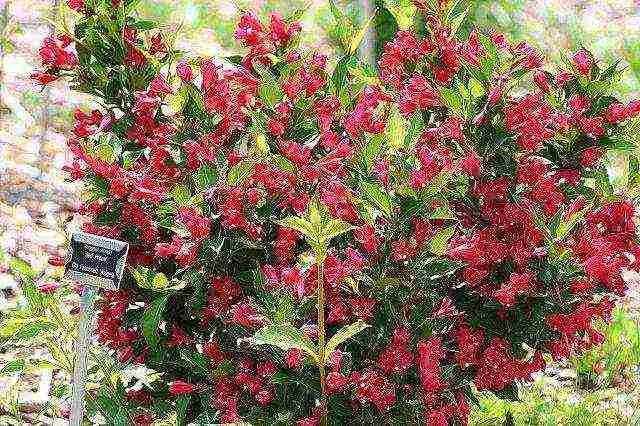
"Red Prince" grows well in sunny and slightly shaded areas, requires protection from the wind. Does not like waterlogging of the soil and stagnation of water in the roots. In the heat, additional watering is required. Not demanding on the quality of the soil, grows well on compacted soil. On poor soils, fertilization with humus, peat, and rotted mulch is required. Shrub pruning should be done regularly to remove damaged shoots and achieve a neat bush shape. When pruning the weigela, it should be borne in mind that flowers are formed on last year's shoots, and also take into account the twofold flowering nature of the weigela "Red Prince" during the spring-summer season.
Like all southern plants, weigela red prince needs protection from the cold. Experienced gardeners are advised to approach the preparation of weigela for winter by analogy with the insulation of garden rose bushes. Long shoots of weigela are wrapped in burlap, covered with spruce paws, as well as with modern covering materials. If the shoots are damaged by frost, they are cut off. Weigela quickly restores the crown damaged by frost, giving less lush bloom in the first year after frostbite.
A bright ornamental weigela shrub, planting and caring for which unfairly frightens some gardeners with its complexity, feels quite well in the middle lane. Knowing the features of this plant and making some effort, everyone will be rewarded with a beautiful and magnificently blooming miracle on their site.
Description
The plant belongs to the honeysuckle family and got its name from the surname of the German botanist professor K.E. von Weigel (1748-1831). The Weigel genus is composed of 15 species that grow in the countries of East Asia and in the southern regions of the Far East (early varieties, Middendorf and Priyatnaya).
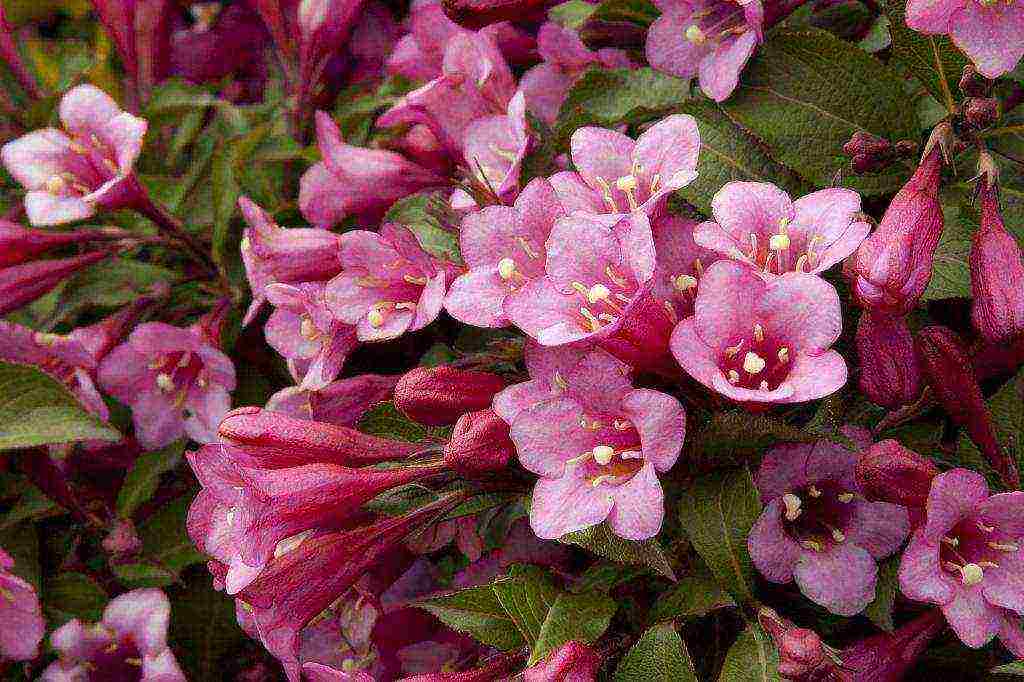
As you can see in the presented photo, weigela, planting and care of which will be given below, is a flowering deciduous shrub with large flowers (up to 5 cm), prone to remontant (re-flowering). Its flowers have a tubular-bell-shaped shape, in some species they look like funnels, the color is all shades from white to bright pink and red, the corolla is two-lipped. They gather in inflorescences, which are located in the axils of the leaves, with repeated flowering - at the tops of the shoots.
The fruit is a 2-fold capsule, inside which small, angular seeds are stored, often with wings.
The decoration of the shrub is in some varieties and leaves with an original color: green with a white border, or dark with a purple frame. However, even with ordinary foliage, the weigela bush looks very elegant, thanks to the numerous bright bell flowers. Another great advantage is the fact that weigela belongs to perennial plants and is able to bloom for 50 years.
Weigela: photo, planting and care in the open field
Weigela likes good lighting, feels best in open areas, some species tolerate a little shade. To plant a plant, you first need to choose the optimal place, paying attention to the purchased variety of weigela, which are divided into 2 main types:
- beautifully flowering shrubs that can be located in a sunny or partial shade place;
- variegated, which are decorative only foliage, but prefer to grow in bright sun.
The advantage of this plant is that it can be planted as a hedge, but it is not recommended to cut it in the future. Weigela bushes, planting and care in the open field for which depend on the species, look great both as a single plant and as components of groups from others (conifers, forsythia, cotoneaster, viburnum, juniper, spirea, etc.).
The main task when planting is to choose a place protected from winter cold winds, because of which the formation of groups of more resistant plants will help protect the weigela from freezing or breaking off fragile branches by the wind, and will also hold snow well.
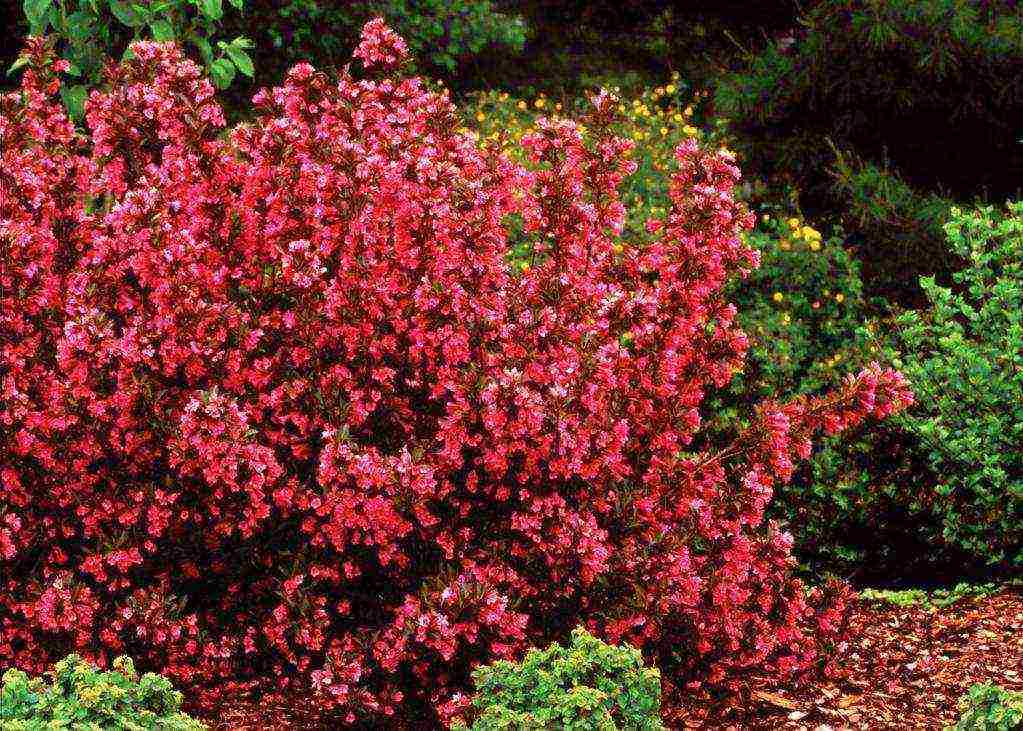
Soil, planting dates and preparation
Weigela tolerates any soil well, but prefers fertile soil with good air and moisture permeability. it does not tolerate overdrying.
Preparing the soil before planting is not difficult: it is enough to dig a hole about 50 cm deep, mix the earth well with compost and 150 g of nitrophosphate. You can make a mixture of humus, sand and turf soil (ratio 1: 2: 2), put drainage on the bottom with a layer of up to 15 cm (gravel with sand).
Due to the low frost resistance, the weigela shrub, planting and caring for which has its own nuances, is best planted in the spring so that it has time to adapt and take root, it is better after the soil thaws and snow melts in April. Saplings should be purchased when 2-3 years old, younger ones do not take root well.
Considering the size of adult plants, when planting in groups, it is recommended to keep the distance between the bushes at least 3 m. The root collar of the plant cannot be buried; it will go down with the ground. It is better to mulch the soil on top to avoid drying out.
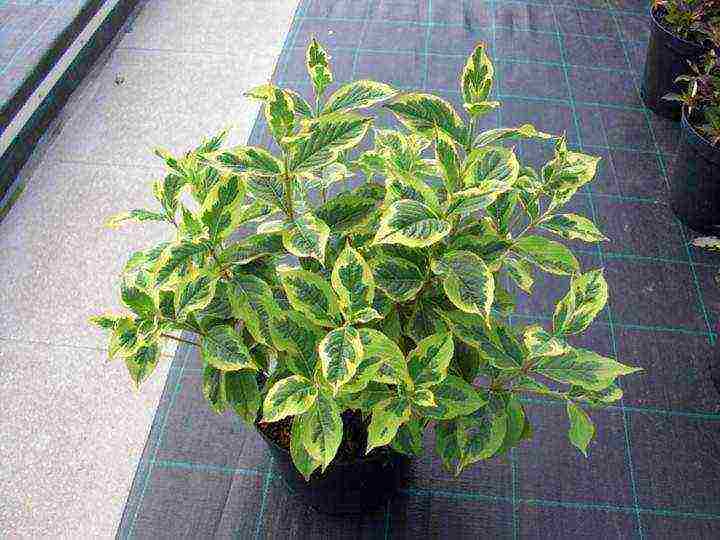
Watering and caring for weigela
Weigela belongs to moisture-loving plants, so it must be watered abundantly and regularly, after which it is imperative to loosen or mulch the soil surface in the near-trunk circle.
Top dressing has a very positive effect on the beautiful and abundant flowering of the shrub, experienced gardeners advise doing them twice a season:
- first in early spring, even before the snow melts: a mixture of 10 g of potassium sulfate, 10 g of superphosphate, 20 g of urea is poured on top;
- during the formation of flower buds, in early June, feeding is carried out with a mixture of potassium sulfate, double superphosphate, 30 g each.
Newly planted young bushes must be additionally fed in September with phosphorus-potassium fertilizers to strengthen and adapt before winter.
Wintering weigela
In addition to planting and caring for weigela in the open field, wintering is a very important period. To protect the shrub from death as a result of freezing, only winter-hardy species should be purchased, which are maximally adapted to the local climate. This should especially be taken into account by novice gardeners who dream of keeping up with the splendor and beauty, not taking into account the possibilities of plants. At first, it is recommended to buy more hardy types of weigela, and then switch to refined and original ones.
The ideal option is considered to be planting material: a seedling grown by cuttings from a neighboring bush, which has been growing successfully for several years.
The only reliable way of wintering a weigela is to cover it for the winter months, it will be optimal to use covering materials (spunonda), which is wrapped around the entire bush. The soil should be covered with spruce branches or sawdust, even better - build a frame of wood or wire around the plant, covered with insulating material on top, inside - filled with dry leaves. This method will help to hide the trunk and branches of the bush from frost and cold wind.
If the weigela is slightly frozen, then experienced gardeners advise trying to water it abundantly at the rate of 1-2 buckets per bush. During the winter, you need to monitor the plantings and clear the excess layer of snow so that the branches do not break off from its weight.
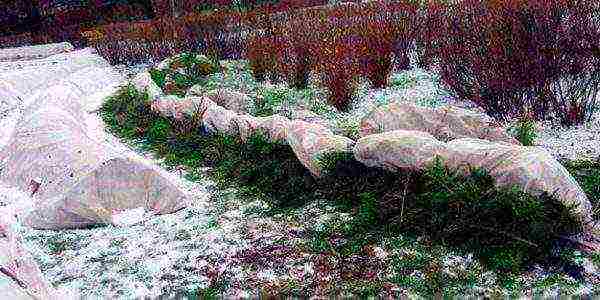
Spring pruning
It should be remembered that pruning is carried out only in the spring, after the cover of the bush has been removed. It is imperative that the pruning of the frozen ends of the branches is done, as well as those that are completely frozen. This sanitary pruning is done annually.
Once every 2-3 years, it is necessary to do formative pruning, which is done after the flowering of the shrub in the summer. It is necessary to remove weak shoots and those that are directed towards the center of the bush. Productive branches are cut to 1/3 or 1/2 of the length. When forming the crown, young shoots are pinched, this is done during the break between cutting.
After such a procedure, the shrub often blooms again, so it is better to immediately water it and feed it with complex fertilizers.
Reproduction
For weigela, the optimal and most reliable way of propagation is rooting a green cuttings. For this method, during the budding period, a 10-12 cm long stalk is cut off on a young shrub, on which there are 2 leaves.
For weigela, planting and caring for cuttings should be started by soaking them in a stimulating solution (Epin, Heteroauxin, Kornevin, etc.) to form roots for 8-12 hours. Then they are planted to a depth of 1 cm into the soil , mixed of peat and sand in equal proportions, in a shaded corner of the garden. Cover the top with a jar or make a small greenhouse made of polyethylene.

Care consists in daily watering (preferably 2 times), then after 1.5 months. it will take root well. It is not necessary to rush to replant, it is better to grow it for another 1-2 years, covering it well for the winter. During this time, he will grow up and get stronger.
Reproduction by seeds, which are sown in spring, is also practiced, at home in pots, which are covered with glass on top. A pick of seedlings is done after the appearance of 2 leaves.It should be borne in mind that seeds taken from bushes of hybrids and garden forms of weigela often do not retain varietal characteristics. Therefore, grafting is the more common method.
Shrub species
In the conditions of central Russia, 3 types of weigela shrubs grow, planting and caring for which make it possible to tolerate frosts well:
- Blooming (Weigela florida).
- Middendorf (Weigela middendorffiana).
- Early (Weigela praecox).
It should be borne in mind that with age, the bushes become more and more resistant to cold climates.
Weigela blooming
It is a shrub up to 3 m high, widespread in Japan, in the north of China, in Primorye. The leaves are short-petiolate, ellipsoidal, pointed at the tops, pubescent below. The flowers are bright pink, abundant on the bush, the flowering time is May-June for 20 days. Recommendations for weigela blooming for planting and care: the plant prefers moist, slightly acidic soil, in case of severe drought it needs watering. It grows quickly and is used in both single and group planting.
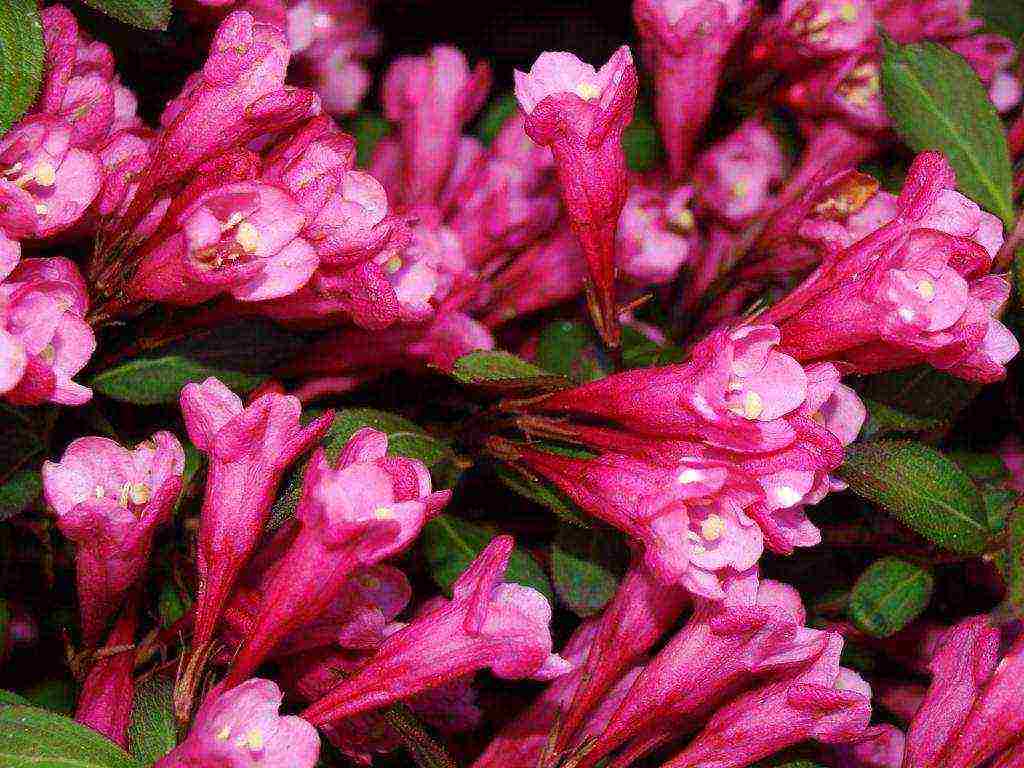
The most popular garden forms:
- Veigela Victoria, planting and caring for which consists in frequent watering and covering a young bush for the winter, is distinguished by the original color of brown-red leaves, which increases its decorative effect (photo above). Its height does not exceed 1.2 m, it grows more slowly (10-15 cm per year), flowers are bell-shaped, purple-red, 3-4 cm long, inside are pale pink, collected in 3-4 pieces, appear in June and July.
- Purple (Purpurea) - a bush up to 1.5 m high, having brown-red ellipsoidal leaves up to 8 cm long, flowers of a bright pink color, the middle is yellowish; flowering time: June, hibernates only when covered.
- Variegata (Variegata) is a shrub up to 2.5 m high, it tolerates frost better, the leaves are small, up to 5 cm long, the flowers are white-pink, collected in a brush; for weigela Variegata, planting and leaving (photo below) does not present any great difficulties.

- Blooming Nana Variegata - a shorter shrub (up to 1.5 m) spherical, bright green leaves, edged with a cream border, flowers are collected in inflorescences of 4, small up to 2.5 cm, color - white-pink or crimson, grows slowly. Recommendations for weigela Nana Variegata: planting and care (photo below) for her consist in regular watering and dressing, average frost resistance, planted singly or in groups.

Weigela hybrid
Breeders have bred special hybrid forms of this shrub that feel comfortable on the territory of Russia. These are weigela forms, planting and caring for which in the suburbs becomes much easier, because plants are less demanding on climatic conditions.
The hybrid shrub (Weigela hybrida Jaeg.) Grows up to 1.5 m in height, has a spreading crown, branches are dotted with inflorescences collected in lush tubular-funnel-shaped flowers, which bloom preferably on young shoots, emitting a pleasant aroma. The color of flowers is presented in many shades: white, pink, pink-violet, purple, violet-carmine.
Hybrid forms of weigela, which were obtained by crossing, differ in color and shape of leaves and flowers:
- Bristol Ruby — grows up to 3 m, has bright green elongated leaves up to 10 cm, flowers have a colorful ruby-red border, the middle is red-orange, flowering time is June; planting and caring for the weigela (photo Bristol Ruby below) - similar to other species.

- Eva Rathke is a short shrub (up to 1 m), a hybrid of Korean and profusely flowering forms, the leaves are ellipsoidal, bright green, up to 10 cm long, the flowers are tubular, shiny, carmine red, in the middle - slightly lighter.
- Rose (Rosea) is a spreading bush up to 1.5 m tall, decorated with large flowers, bending in the shape of a spikelet, pink with white transitions. Of the species listed, Rosea is the most frost-resistant, requiring a small leaf cover for the colder months.
- Red Prince is an American cultivar that received an award from the Royal Society of Horticulturalists of England in 2002, where an increased number of bright red bells on each branch was noted, also has a long flowering duration, good frost resistance.Planting and care for the Red Prince weigela are simple, the plant is unpretentious, its height reaches 1.5 m, its width is up to 1.6 m, the flowers are bright crimson, blooms twice.
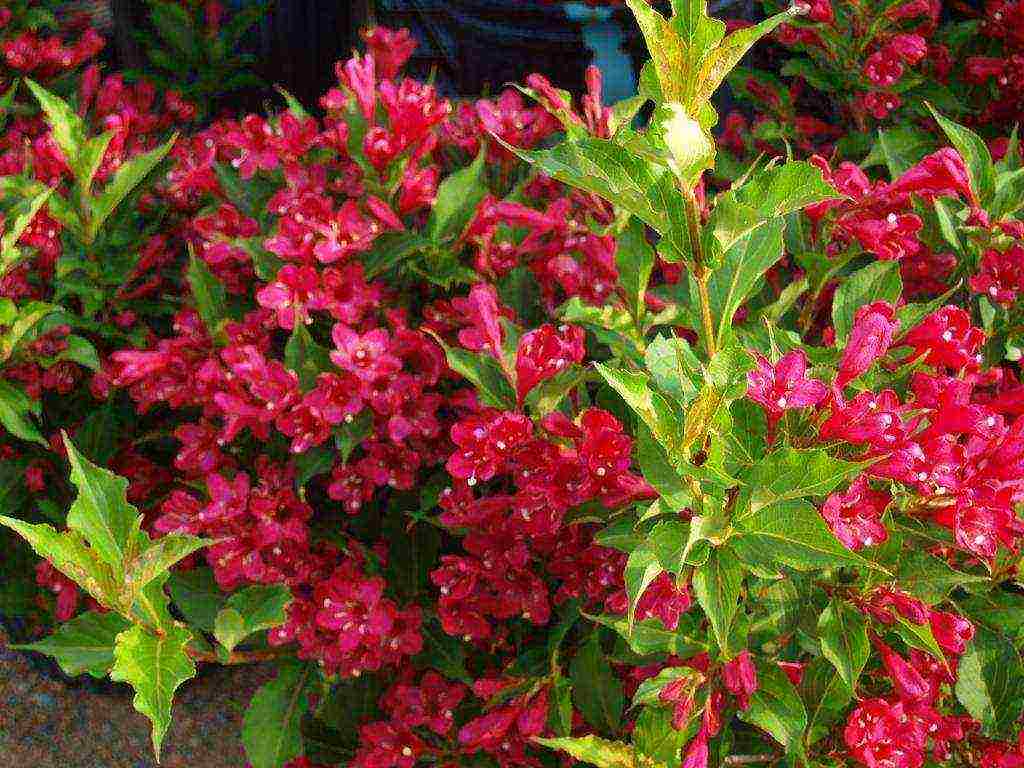
Weigel Middendorf
Such a shrub is widespread in the undergrowth of coniferous and deciduous forests in the Primorsky Territory of Russia, is found in cedar forests, and is also known on about. Sakhalin, Japan and northern China. Weigela Middendorf is located in separate bushes, less often in groups, on wet slopes, along rivers it forms thickets, comes across on rocky placers.
The height of the bush reaches 1.5 m, has elongated leaves, large flowers are collected in inflorescences of several pieces, the color is yellow with orange dots inside. A feature of this species, with proper planting and care (photo of Middendorf variety weigela below), is the ability of the bush to bloom twice a year (in May-June and September-October), respectively, and the seeds ripen 2 times.
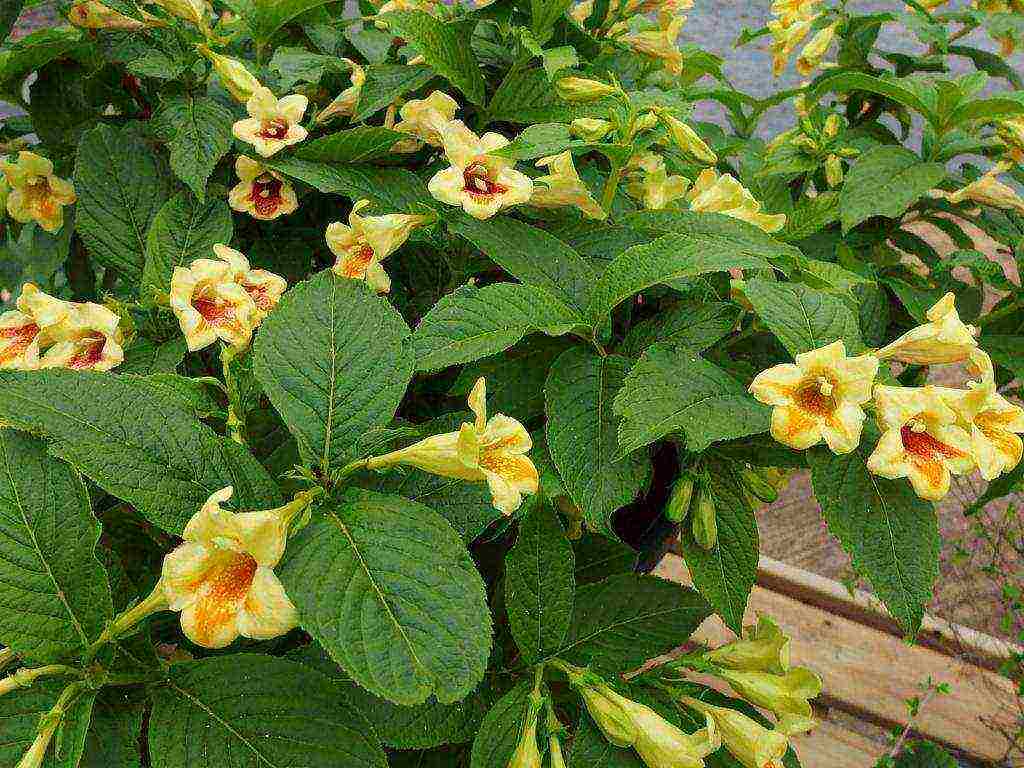
In the autumn months, the color of the leaves on the shrub changes, and leaf fall occurs throughout October. This species, according to gardeners and breeders, is considered the most promising for decorating and landscaping the landscape, due to its graceful appearance and original colors.
Weigela early
In nature, it can be found as single bushes or in groups in the southern part of the Ussuri region on the edges of forests and on slopes, as well as in China and North Korea. This plant is a tall (up to 2 m) spreading dense shrub with gray bark and brown branches, its young shoots are reddish in color. Leaves - elliptical or ovoid oblong, pointed at the ends, pubescent on all sides. During the season, they change color from colorful green to yellow-brown in autumn.
In the winter months, this species is prone to freezing, and it must be covered, which is done in the same way as the planting and care described above. Early weigela flowers are bright pink and are arranged in three on peduncles, the flowering duration is 1 month, which increases the decorative effect of this plant.
Early weigela shrubs are often used for hedges that do not need to be trimmed.

Diseases and pests
All types of weigel are resistant to diseases and pests. Sometimes the bushes can be affected by aphids, powdery mildew, leaf rollers, fruit moths, etc. For plant protection, it is recommended to do fungicide treatment: preventive spraying in spring.
The most dangerous pest is considered to be khrusch, against which shrubs are treated in April with preparations containing imidacloprid (Prestige, Antikhrushch, etc.). In this case, the solution should be applied not only to the crown, but also to the trunk and root collar. Spraying is carried out every 40 days during the growing season, and "Aktara" is applied in the same way.
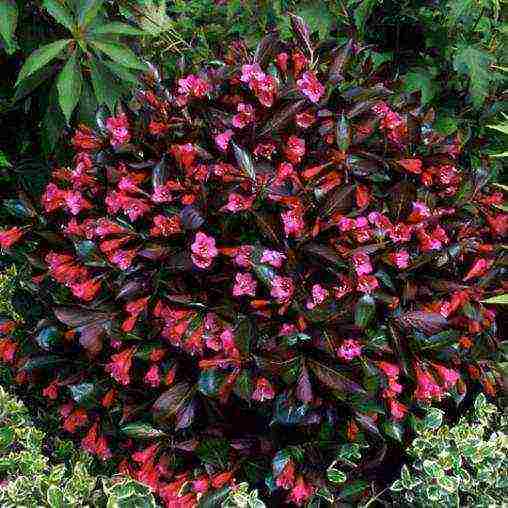
Use in landscape design
Various forms of weigela, planting and caring for which are not very difficult, if we take into account the peculiarities of its development and wintering rules, can be planted both as separate shrubs and in groups, used in borders, trellises, in contrasting color compositions. Blooming weigels look picturesque and bright against the background of green lawns.

Beautiful and bright weigela flowers look very impressive in garden design and it is not surprising that this flowering shrub has won the hearts of many gardeners. Weigela, planting and caring for which is not difficult, but still provide some rules, is able to fit into any garden design because the flower has a wide variety of shades.
Content:
general description
Weigela is an ornamental flowering upright shrub... On average, the height of an adult plant reaches one and a half meters, but some varieties can be less than a meter, while others reach three meters. It has elongated, pointed leaves with veins, the edges of which are smooth or serrate.The most common leaves are green or reddish, some varieties differ in a different color of the leaves.
The flowers are large enough, tubular or funnel-shaped. The color scheme is diverse, most often there are flowers of cream, white, different shades of red or pink. Of particular interest is the change in the color of the corolla during the flowering process.
Weigela Carnaval
Flowers are located singly or in small inflorescences. The flowers have no smell. Often, weigela blooms twice a year, it depends on weather conditions and on the correct care of the plant, however, re-flowering is distinguished by a smaller number of flowers.
An interesting feature of the ornamental shrub is that flowering begins even before the foliage appears and it looks magical - many flowers are located on the branches... This plant is often used to ennoble the garden plot, decorate it and give it a special charm. In most cases, the shrub does not tolerate frost, but some varieties are resistant to cold weather and take root well even in Siberia.
back to menu ↑ Species and varieties
Weigela has more than fifteen varieties and many species, however, in our latitudes, varieties that easily tolerate cold are the most popular, for example weigela is pleasant, it is also early.
Weigela Suavis
The shrub of this variety grows up to two meters in height, the crown is spherical, and the foliage is slightly lowered... Flowers of a bright pink color are formed in inflorescences of 2-3 pieces. In some cases, the pharynx of a flower may have a white-yellow color. The flowering period of the early weigela falls on the end of May and lasts from ten to thirty days.
back to menu ↑ Variegata
Weigela Variegata Weigela variety is pleasant. A distinctive feature is bright green foliage, on the surface of which yellow spots are located, and in the summer they become creamy.
back to menu ↑ Florida (blooming)

Weigela Florida (blooming) The bush can reach a height of three meters. The leaf is serrated. Flowers are collected in inflorescences of 3-4 bright pink flowers. They begin to bloom in late May and continue to bloom for three weeks.
Its most famous varieties:
back to menu ↑ Purpurea (Purple)

Weigela Nana Purpurea The height of an adult shrub reaches one and a half meters, has a dense crown with reddish brown leaves. The color is pink, the throat is yellow. Flowering occurs in June-July.
back to menu ↑ Alba
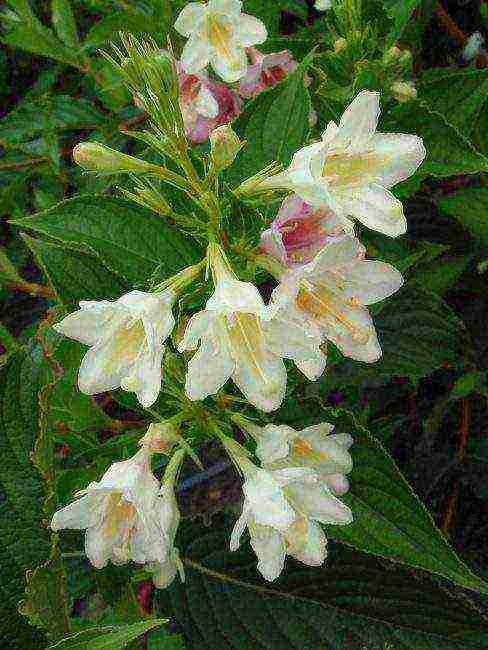
Alba Miniature bush. The flowers are white, which in the process of flowering acquire a pinkish tint.
back to menu ↑ Victoria

Victoria The height of the bush reaches one meter. The foliage is brown-red in color. The flowers are crimson.
back to menu ↑ Hybrid
Differs in a wide spreading crown. Abundant flowering. The height of the bush is on average one and a half meters. The flowers are tubular-funnel-shaped, located singly or in small inflorescences.

Weigela hybrid rumba
The color depends on the variety, it can be white, purple. Pink, lilac or purple-red.
The most popular are the following:
back to menu ↑ Bristol Ruby

Bristol Ruby Sufficiently tall bushes, the height of which is about three meters, and the crown is up to three and a half meters in diameter. The color of the leaves is bright green. The flowers have an orange throat, the predominant color is pink with a darker edge. The flowering shrub falls at the end of June. Differs in rapid growth.
back to menu ↑ Red Prince

Red Prince The height of the bush is no more than one and a half meters. The crown is wide and spreading. The flowers are rich in red color, the foliage is bright green.
back to menu ↑ Middendorf
Weigela Middendorffiana
Weigel Middendorf A low shrub, its average height is one and a half meters.Yellow flowers with an orange throat are especially large, there are specimens of about 4 cm. They are located in inflorescences of 2-6 pieces or singly. Flowering is often observed twice per season.
The described varieties are far from all varieties, and gardeners also grow such species as weigela Maksimovich, Korean, Japanese, pink poppet, carnival, minor black, alexandra, weigelaolimpiada and others.
back to menu ↑ How to plant a plant correctly
In order for your plant to delight with its beauty for many years and give an abundant amount of magical flowers, it is very important to take a very responsible approach to the issue of planting. It is necessary to choose the time and the most suitable place for the shrub. It is optimal to plant in spring during the period when the soil is just beginning to warm up, and the buds have not yet swollen, it is at this time that the shrub has the best survival rate.
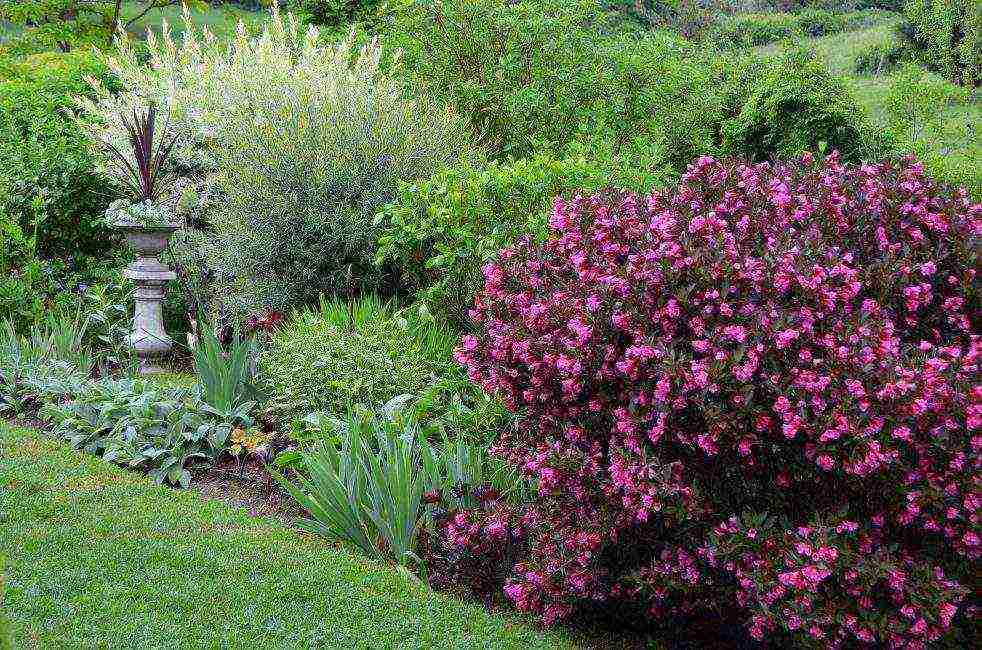
Weigela bush in the garden
Autumn is not the best time for planting, since the bush does not have time to adapt and the very first frosts can lead to the death of the plant.
It is important to choose the right landing site. It is best to give it up if it will be a place on a small hill, which will not be exposed to winds from the north side and will be protected from drafts. Drafts can be dangerous for buds and flowers - they can simply crumble. The best location for the weigela is the south side.
Place the shrub correctly in a well-lit area, since light is needed for flowering and an abundant number of buds. The soil should be saturated with humus and have a loose structure. It is recommended to plant seedlings that have reached the age of three.
back to menu ↑ Landing in open ground 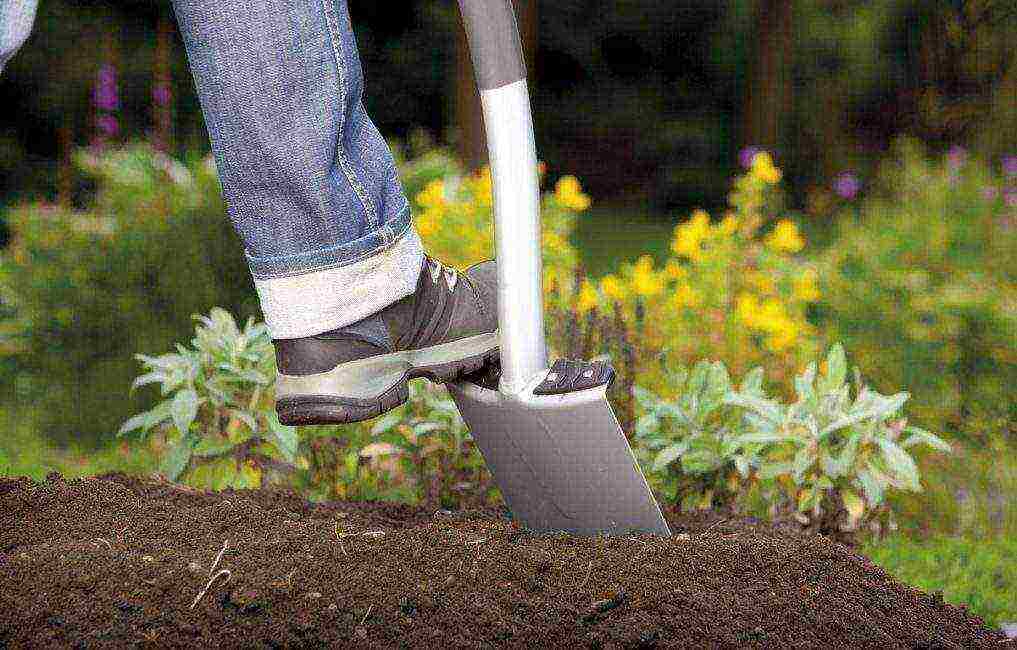
Shrub planting
Consists of several stages:
The first is to choose the right place to plant the seedling. The place should be moderately sunny or in partial shade. Do not choose too shaded places, this plant does not like shade.
If there is a border on the leaves, then such a seedling must be planted only in a sunny place, since it is a light-loving variety.
Particular attention should be paid to protection from wind and drafts. A fence, building or other shrubbery can be used as protection. If there is no protection, then gusts of wind will pluck the flowers.
After choosing a place, we go directly to planting seedlings. For this, a hole is dug about fifty centimeters deep, if the land is fertile, then intensive feeding is not required and the depth can be reduced to forty centimeters. The dimensions of the pit should be 50 by 50 cm.
If you are planting more than one seedling, then it is worth ensuring that there is at least eighty centimeters between them for a low-growing variety and at least two meters for a tall variety. It is advisable to remove weeds and roots from the site as much as possible.
The bottom of the dug hole should be filled with drainage, for this a layer of sand and gravel is used. The optimum height of the drainage layer is not approximately fifteen centimeters.
The seedling is placed in a hole and carefully filled up with the prepared mixture: two parts of sand, two parts of leafy earth or humus, one part of sod land. If the soil in your garden is not very fertile, then compost is added to the mixture, about fifteen liters per bush, and one hundred grams of nitrophoska.
Do not over-compact the soil, the roots feel more comfortable in a little loose soil. It is important that the root collar is clearly level with the ground.
If a container was used to grow the seedling, then the release of the root system from the ground is not required, planting should be done immediately with a lump. After that, you need to provide abundant watering. Next, you need to mulch along the root circle.
If you know that the survival rate of the seedling is under threat, then the plant is preliminarily treated with special agents that stimulate growth.
back to menu ↑ Plant propagation methods
Weigela is propagated in several ways:
- seed propagation
- reproduction by layering
- vegetative propagation
back to menu ↑ Seed propagation
The overwhelming majority of weigels that can be found in our regions are hybrid varieties. They differ from their wild brothers in a larger color palette, their flowers are larger, and the color of the leaves is more saturated, the color of the leaves is often purple. The disadvantages of this method of reproduction include the fact that it is not able to convey all the characteristics of the variety of the propagated plant.
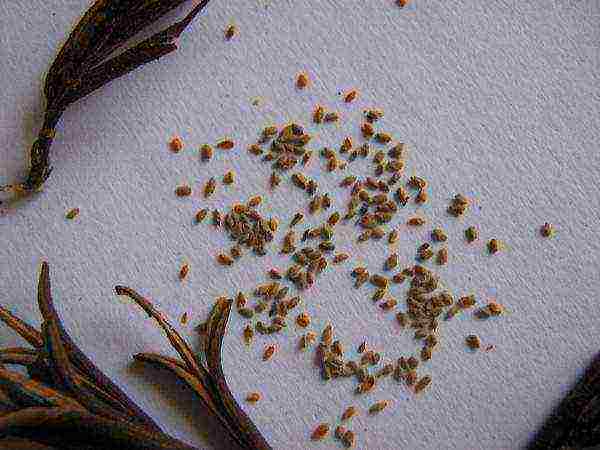
Plant seeds
But there are several rules for seed propagation. The first thing to remember is that the seeds have a short shelf life and after a year they already lose their germination. It is necessary to sow seeds in the spring in special pots, in which a special mixture is placed: two parts of soil and one part of sand. A small layer of sand is poured directly.
Next, the sowing must be covered with transparent glass and placed in a warm place. It is important to air the seed pot periodically and water it carefully, and it is best to use a spray bottle for watering, which is used to spray the surface of the soil. After three weeks, the first shoots will become noticeable.
When two leaves are formed on the seedlings, you can place them in separate pots. In new containers, observe high humidity, keep the plant under a film until it begins to grow.
Weigela propagation by self-seeding is also known, but in this case it is practically impossible to plant a young seedling. This is due to the fact that self-sowing is already possible in adult plants that require less careful maintenance; compacted soil is suitable for them, in contrast to young plants. Trying to plant a young seedling from dense soil, weak roots are injured or even break off and the plant does not survive.
back to menu ↑ Reproduction by layering
Reproduction in this way is carried out in the spring. For this, a twig is taken, which is located near the ground. It is bent a little and a small incision is made in the wood. The resulting incision must be processed with a special prepared mixture of root and activated carbon powder.
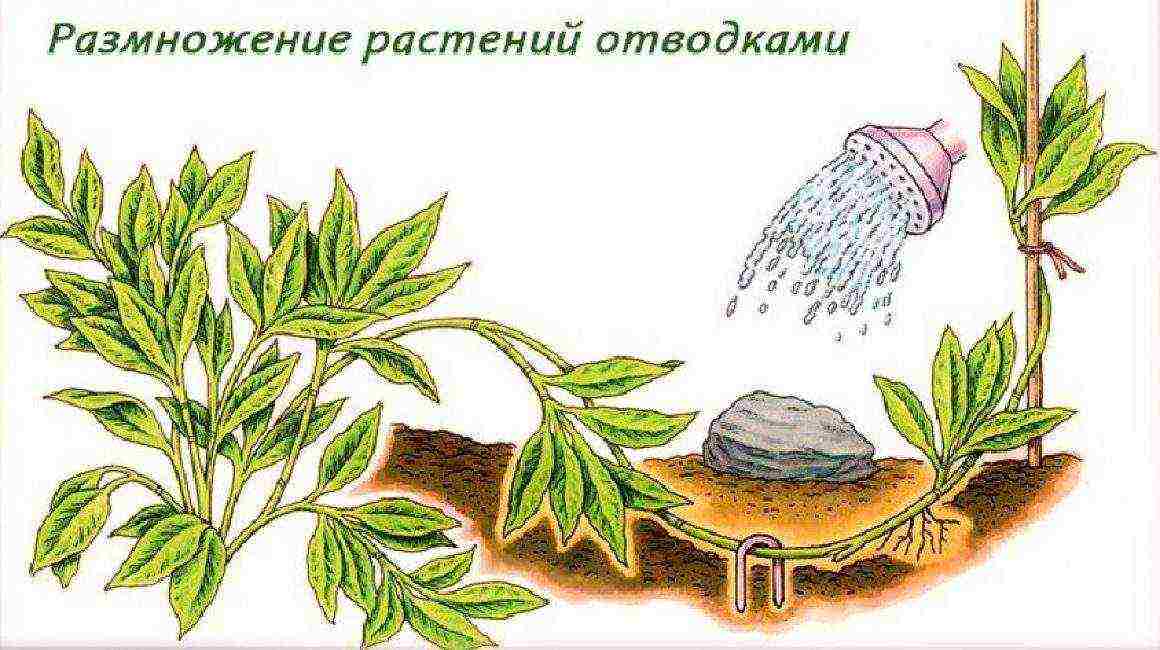
Scheme of obtaining a layering from a plant
Next, a match is inserted and buried in such a way that the resulting cut is placed in the ground. Studs or small metal arcs can be used to secure the layering. In the fall or next spring, the new plant must be cut off from the mother plant and planted in the place chosen for it.
back to menu ↑ Vegetative propagation
The best of all the options considered is vegetative reproduction., namely propagation using cuttings. If your goal is to get a large number of young shoots, then the first thing to do is to choose a strong and healthy plant with abundant flowering, which will act as a mother bush. Its main purpose is to bring the maximum amount of healthy and strong cuttings.
Initially, it is necessary to get rid of all obviously weak shoots, they need to be cut off at the root... Strong shoots also need to be cut, but only to half. Prune as many branches as you need new plants. Shoots that grow back after pruning are much more capable of new root formation than a plant that has not been pruned.
In the process of cuttings, the upper part of the shoot is cut off only if it has not been able to ripen. The length of the cuttings is ten to fifteen centimeters.
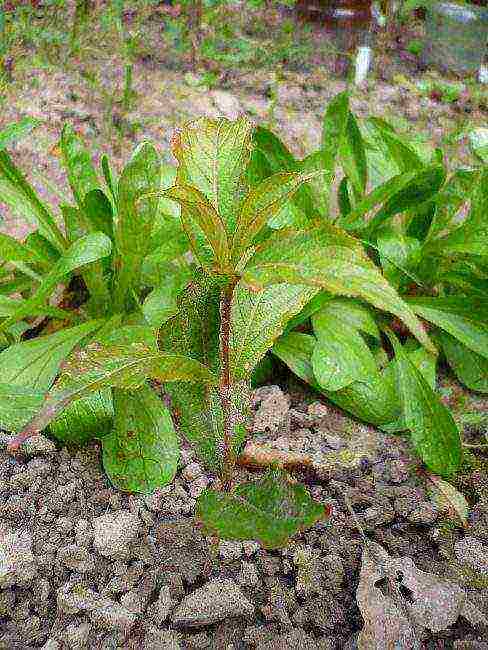
Rooted cutting planted in open ground
The oblique cut at the bottom should be half a centimeter below the bud, all the lower leaves are cut off and specially treated with a stimulating drug.
For rooting a large number of cuttings, it is convenient to use a cold greenhouse, and if you need several cuttings, then a regular pot will do., into which drainage is poured at the bottom and covered with soil from above, and then covered with three centimeters of sand. After that, holes are made in the soil with a special wooden stick and prepared cuttings are planted in them, deepening each by four centimeters. After planting, watering with fungicide is carried out, the pot is covered with a film and placed in a darkened and warm place.
Subsequent care provides for the correct watering regime and timely airing of the cuttings... With the arrival of spring, the shelter of the cuttings can be removed when the formed shoots are noticed. Such cuttings can be planted after a year and a half. During this time, it is advisable to pinch the plant several times.
The process of reproduction of weigela with lignified cuttings is quite laborious and it will be quite difficult for novice gardeners to achieve success on the first try.
back to menu ↑ Care
The mild climate of the southern regions is best for growing weigela... However, some varieties perfectly tolerate the climatic conditions of other regions. For example, early weigel takes root well both in the Moscow region and in the Leningrad region. But such varieties as profusely flowering, Korean or pleasant weigela require additional insulation in winter in these regions, since frosts negatively affect the plant, especially on young bushes.
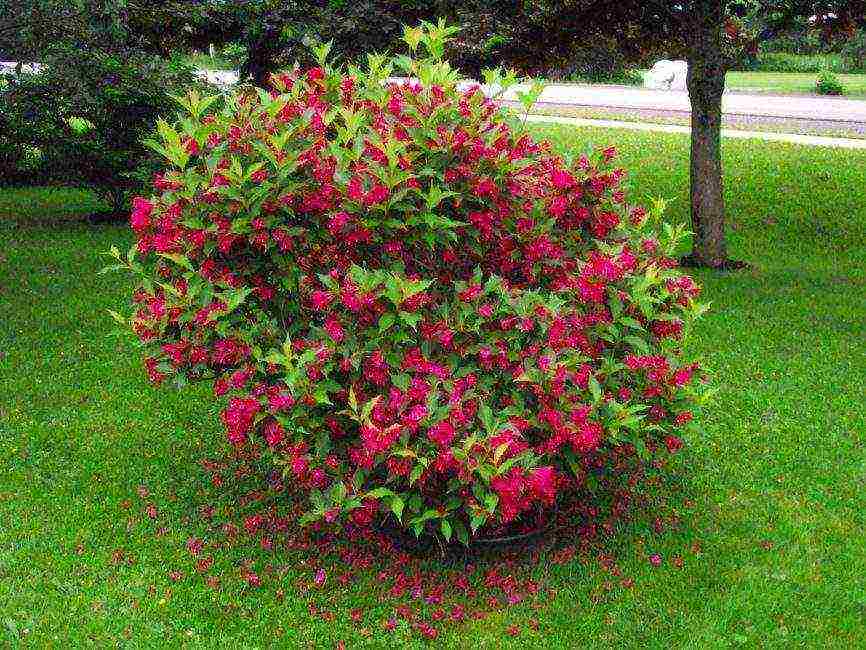
Beautiful bush Red Prince
For adult plants that grow on the site for at least three years, slightly less care is required, since they are more winter-hardy. In winter, in order to avoid breakage of the branches, it is periodically required to shake off the snow from them, especially during the snowfall period.
From time to time (not every year), the bushes suffer from pests or diseases. This affects the growth of the shoots, reduces winter hardiness and can cause the lack of flowering. To protect the plant from fungal diseases, a mixture of milk of lime and copper sulfate is used.
As a preventive measure against leaf spot or rust, the drug Topsin is used. A 3% solution is applied before the buds have blossomed, and a 1% solution during vegetation.
When to collect seeds
- At the beginning of September, the process of seed ripening begins, in November you can notice how the capsules begin to crack, it is then that the seeds should be collected.
- In order not to lose the seeds and so that they do not spill out on the ground, you need to wrap the testes with gauze back in September.
- To collect the seeds, when the time is right, the box in gauze is cut very carefully.
- Next, in the room, you need to remove the gauze layer and pour the seeds onto the paper, then dry them and then place them in a paper envelope.
- To avoid confusion, be sure to sign the envelope, indicate the name of the variety and the date of collection of seeds. After that, the seeds must be sent to a dark and dry place, where they will be stored until the onset of spring.
- Keep in mind that you can store seeds for no more than one to two years. After this time, the seeds lose their germination.
Diseases and other problems
- Weigela, like other plants, is susceptible to various diseases and can be affected by parasites. Spider mites, thrips, aphids or caterpillars can harm the plant.
- To combat these pests, there are many drugs, both biological and pesticides, that can be purchased in specialized stores.
- If you are not a fan of store products and trust only folk methods of fighting parasites, then infusions of bitter pepper, wormwood or garlic are considered a proven option; laundry soap in the form of a solution is also used.
- Fungicides are used to protect the plant or eliminate existing powdery mildew or rust.
- As prophylactic agents, solutions of epin and zircon are used, with which weigel is processed when foliar dressing is applied.
Weigela Blossoming (cultivar ‘Minuet’)
Reasons for the lack of flowering
- Sometimes gardeners are faced with an unpleasant problem - the lack of flowering. This situation can have several reasons. The first and most common reason why a shrub does not bloom is planting errors. For example, if the place was chosen incorrectly and the shrub receives less light, then the absence of flowers is the first news of problems with growth, then there may be a delay in the maturation of seeds or lumbering of the shoots.
- Often, flowers are absent due to insufficient watering and too dry soil, or due to a lack of necessary nutrients.
- Parasites can damage the root system. And plants that have root problems are unlikely to be able to fully grow and bloom.
back to the menu ↑ How to prepare a shrub for winter
In order for the winter period to pass favorably for the plant, it is important to comply with the existing rules throughout the growing season. Wintering is most easily tolerated if favorable conditions have been created for the plant: it grows in a sunny and sheltered place. Throughout the year, it is necessary to observe the watering regime in such a way that the soil is not too dry or too wet.
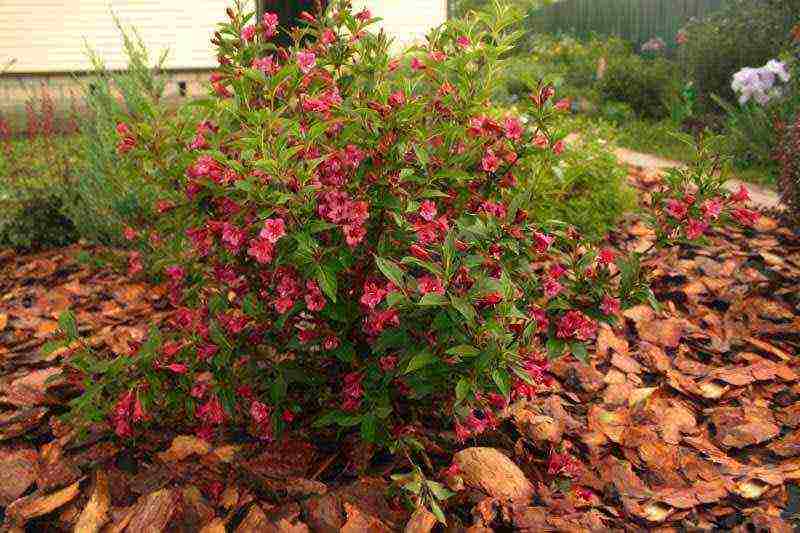
Preparing a bush for wintering
By the second half of summer, it is advisable to stop fertilizing, thus, the growing season will be completed before the first frost.
Before frost sets in, it is required to loosen the soil around the bush, after which they huddle and create a mound no more than 20 cm in height. Even if there is no suitable shelter for wintering, then these actions will help the plant to endure the cold. All leaves that have fallen in autumn must be removed for the winter, since they are a favorable environment for the development of parasites and sources of fungal diseases.
Don't overdo it with insulation. It is not necessary to insulate the bushes too early, a slight frost is good for the plant. Warming should be started only with the onset of stable frosts.
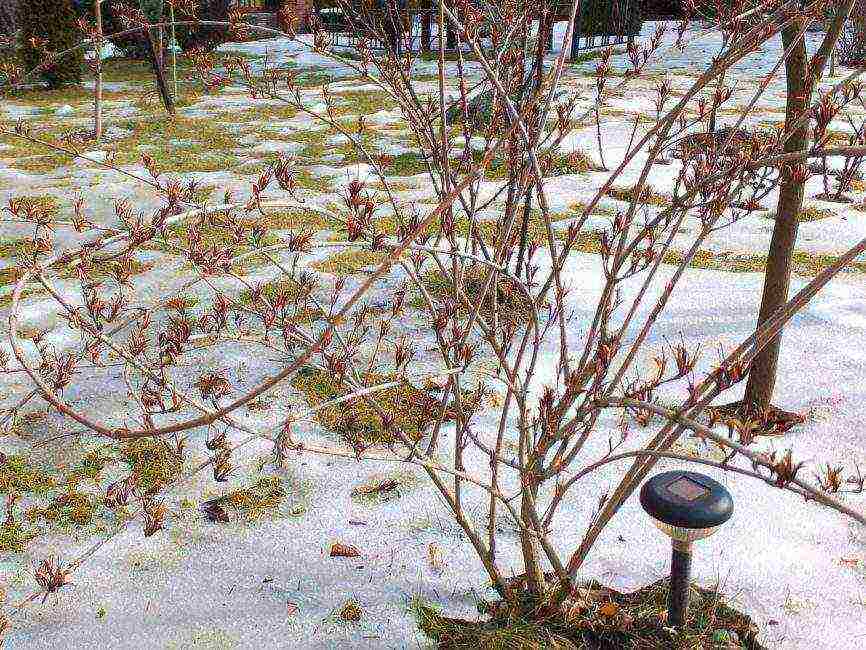
Bush after wintering
If you decide that it's time to start preparing the plant for winter, then for easy wintering of the plant, you must complete all the preparatory measures. Particular attention should be paid to young shrubs, because they are most susceptible to frost, adult plants are already more resistant to temperature extremes.
Before hilling the bush and sheltering, it is necessary to treat the near-stem part of the bush with a fungicide, this is necessary to prevent the development of fungal diseases... Also, to protect against fungus, the shelter should be carried out exclusively in dry weather and do not allow moisture to enter.
Basically, gardeners use one of two methods of insulation:
Bending branches
- This method, as the name implies, involves bending the branches.
- To do this, they must first be tied, and a special material should be laid under the bush itself - spruce branches. Here, metal arcs are also used, weigela branches will be fixed on them.
- On top of the structure, we place a protective layer of spruce branches, which will act as a kind of blanket, and also cover it with a film on top to protect it from moisture.
- It is very important that the plant is reliably protected from moisture ingress. Otherwise, there is a risk of fungal diseases.
Air dry
- The first step is to install the frame, various boards or sticks are suitable for this, but here it is worth considering the height of the bush, it is convenient to use metal arched rods.
- We cover the built frame with lutrasil or spandbond. The void that forms in the process is laid with spruce branches.To protect the structure from getting wet, it is covered with a film, which is fixed with cobblestones.
- As you can see, there is nothing complicated. It is worth noting that snow acts as a natural shelter, and if there is little snow in winter, then a warmer shelter should be provided.
- After completing all the measures for wintering, in the spring you will admire a beautiful, healthy and flowering bush. Watch the video on the Weigela Ornamental Shrub and you will know everything you need to grow and care for your plant.
7.8 Overall Score
Feedback from our readers is very important for us. If you disagree with these ratings, leave your rating in the comments with the reasons for your choice. Thank you for your participation. Your opinion will be useful to other users.
Add your review


